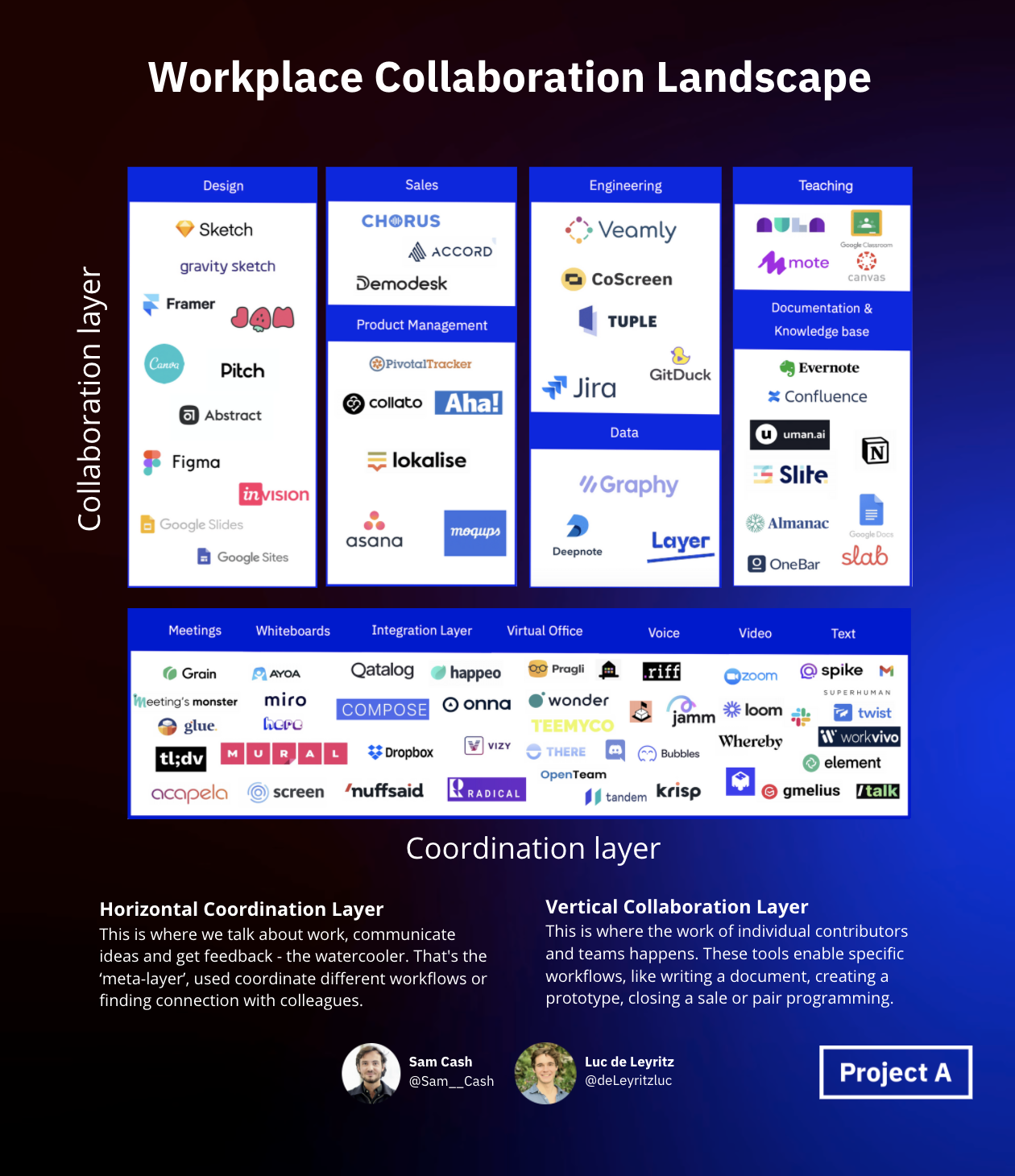By Sam Cash
Collab tools are having a moment — driven by the secular trend of remote work, and covid enforced WFH. We explore the new entrants in this market, the factors driving the unbundling of many of the existing tools, and what this means for founders.
Started from single-suite software now we’re here
To an increasing extent, we’re seeing the death of breadth in favour of depth. We’re shifting from the single vendor productivity software suite, namely Office. To a largely browser-based suite of workflow specific productivity and collaboration products.

Microsoft Office and specifically Excel typifies breadth, an unopinionated general-purpose tool, which is *still* used for a seemingly infinite number of tasks. With the recent exception of Notion, the general theme is clearly towards depth — unbundling general productivity into specific workflows.
Today, most of these tools leverage the browser and the universal language of URLs, making sharing and virality key components of many of these tools. Browsers have made both UI, integrations, and extensions easier, additionally, tabs allow for much easier context switching than apps. Whilst mobile interoperability does feature, we’re really still seeing the desktop browser as the default form factor for collaboration. Now, let’s look at some of the emergent companies and trends….
Trend #1 – The unbundling of collaboration
Tools move from generic communications to specific workflows. Users come from the tool and stay for the work, e.g. Github, ResearchGate
- own the medium: early horizontal tools such as Slack, Zoom “own” the communication medium. They are perceived to be the default communication tool for a specific format, e.g. text, video, audio, etc. This opportunity is quickly fading with the widespread proliferation of solutions across most mediums. For instance, a lot of text communication has moved within vertical tools, and Slack becomes the exception handling solution
- own the workflow: increasingly companies are building a feature set that is native to the desired work output. More mature mediums (video, text) have seen that unbundling happen already, for example, Zoom→ Coscreen, Slack→ Mote, etc.
- come for the tool, stay for the work?: future potential for new work networks and marketplaces based on narrow workstreams within industries. Tool → workflow → network. (e.g. Github, ResearchGate, Dribbble)
- emergence of new collab workflows: we’re seeing a shift from not only visual/design mediums but to other workflows such as finance/accounting, sales, engineering, meetings, etc.
Trend #2 – Emergent meta-layer in collaboration
The number of tools is driving the need for an integration layer that gives context, integrate security & compliance and serve a persistence function
- contextual insights: with many tools and workflows, finding information becomes a problem. There is a need for extracting and surfacing relevant information from a broad segment of communication tools. Critically, data generated from a tool’s usage also has latent business value
- security + compliance: an increase in software surface area is leading to new potential attack vectors and a need for adherence to internal policies. The need for compliance emerging as a trend as large enterprises go remote and workers demand new modes of communications
- persistence + integrations: this layer requires ‘always-on’ background functionality and a growing number of integrations across various tools. It’s hard to achieve but valuable when it enables automation and seamless integrations to build more complex workflows.
Trend #3 – Increasingly hard GTM
Zoom fatigue is only one expression of tool fatigue. With many tools and market noise, founders need to refine positioning, time to value proposition and UX
- time to value: an abundance of new products means that users need to get value out of the box, be a great tool in either single-player or multiplayer mode — if the latter, founders need build functionality to pull people into the product in onboarding
- bottoms-up to top-down motion: the predominant mode of adoption and GTM has been bottoms up with a sprinkling of network effect, given the inherent collaborative preferences of individuals and teams within organisations. As this motion saturates, we expect to see more enterprise-grade products where procurement is through key budget holders, posing a unique product and GTM challenge for founders
- noisy market: getting a wedge into distribution through concise messaging is becoming increasingly important (see The Matrix below). Startups need to laser in early on their most valuable use cases, how to solve these specific pain points for users and to communicate this effectively
- lower k factor: as more tools are built around internal workflows, virality will be weaker as networks are naturally capped in size. This put CACs firmly in focus
If you’re a founder building in this space, feel free to reach out!
Sam
Co-authored by Luc de Leyritz
* BONUS *
The Matrix — understand where you are on the grid and who else is there
There are a multitude of ways to classify a specific collaboration tools’ segment, from; asynchronous v synchronous, internal v external, single-player v multi-player, vertical v horizontal, single media type v multimedia
For most founders, it’s important to understand how crowded your vector on the matrix is, for example;
- Synchronous, external, horizontal, video is going to be crowded (Zoom, Whereby, Meet, Webex, etc.)
- Asynchronous, internal, horizontal, video is going to be less crowded and the competitive dynamics likely healthier (Acapela, Supernormal, tl:dv)
Whilst it’s unlikely that most vectors will produce outsized companies. As a founder, you’re likely to have a better time scaling where there are healthier competitive dynamics.